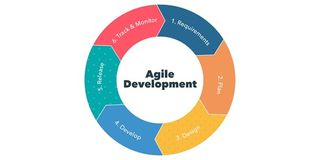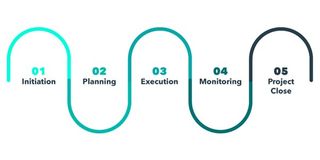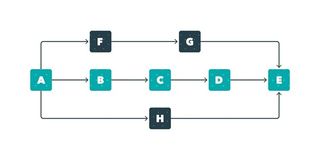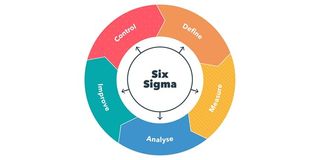The most popular project management methodologies: A comparison
A look at the many different approaches to project management

When a project is managed correctly it helps you to maintain efficiency, hit your targets on time, and, ultimately, be more profitable.
In a recent survey, we found that a staggering 96% of people believe that the businesses they deal with could improve when it comes to communication and project management.
This reveals the extent to which project management, more than being a buzzword or a bland set of systems, tools and processes - can be the very heartbeat of the customer experience. If things aren’t managed well, the customer knows about it. And almost all of us feel there is room for improvement with the businesses we work with.
- Here's our list of the best project management software out there
- We've built a list of the best collaboration tools around
- Check out our list of the best productivity software right now
Samantha Ferguson is Senior Sales Manager at Project.co
But there are many different ways to manage a project
If you’ve heard whispers of kanbans, scrums, and waterfalls and wondered what they are - and what on earth they have to do with project management - then you’re in the right place.
In this article we’re going to demystify the most popular project management methodologies by explaining what they are, their strengths, and their weaknesses, so you can decide which one is best for your project(s)!
What is a project management methodology?
A project management methodology is a system of guided procedures for managing a project. In other words, it’s a set of rules that you play by to get your project finished in the most productive way possible.
Are you a pro? Subscribe to our newsletter
Sign up to the TechRadar Pro newsletter to get all the top news, opinion, features and guidance your business needs to succeed!
The reason there are so many different project management methodologies is because there are different kinds of projects and different kinds of teams. These factors, and more, will help determine which is the best methodology for you.
1. Agile
Agile project management allows team members to break projects into small pieces, or ‘increments’ and review each one before moving forward to the next.
This is great for complex and/or large scale projects because it gives team members a chance to respond to issues as they arise. By making changes at the right time, resources can be saved and teams can feel more confident that projects will fit within the allocated budget.
Agile projects are typically split into six increments:

Requirements - Clearly defining the goals and limitations of a project. Essentially - ‘what’ is required and ‘when?’
Plan - This phase turns the focus to ‘how?’ Which people, tools, resources - and time - are required to deliver on the requirements?
Design - During this phase, the solution is designed and conceptualised.
Develop - The solution is developed and the practical, technical side of things fleshed out.
Release - The solution is launched or made live.
Track & monitor - The performance of the solution is measured and analysed, and the learnings will feed into the next ‘iteration’ or project.
Some of these stages can be omitted depending on the specific ‘shape’ of a project. And what’s particularly interesting about agile development - compared to linear project management - is that it allows each phase to set a ‘broad direction’ which is totally flexible for subsequent increments. This means that rather than setting a goal and ‘hoping’ the target remains the same, teams using agile can ‘hone in’ on the eventual outcome of a project.
The main function of the Agile methodology is to fix problems fast and ensure there is continuous improvement throughout the project.
Great for: Software development
Pros:
- Changes can be made easily and with less risk
- Communication between team members is encouraged
- Increased productivity
Cons:
- Deadlines need to be flexible - as unexpected changes can extend different increment times
- Team members must work closely together and wear many hats
2. Waterfall
The Waterfall methodology is a linear, sequential approach to project management. Each step of the project must be completed before moving onto the next, and progress flows downwards - like a waterfall.
It sounds pretty similar to Agile, but they differ in that Waterfall does not facilitate changes at each increment. Instead, the steps and deadlines for Waterfall projects must be clear from the outset and then the team involved must work together to meet those deadlines.
Waterfall projects can be broken down into 7 steps, but not all projects will pass through all of these:

A key component of the Waterfall methodology is documentation. Before moving on to the next step, team members are required to complete an extensive review, documenting anything of importance. This is crucial as there is no going back to previous stages once they have been approved.
Great for: Manufacturing and construction
Pros:
- Expectations are clear from the outset
- Documentation gives everyone a better understanding of the project
- Progress is easy to measure
Cons:
- Lack of flexibility
- Requirements need to be determined before the project starts
3. Kanban
Kanban is a visual project management framework. It originated from the Toyota production line, hence the Japanese name (roughly translated it means ‘visual sign’).
Kanban is a useful methodology for any teams that want to visualise their tasks and gain a better understanding of their workflow. It’s also known as the ‘just in time’ methodology because tasks are completed only as and when they are required.
Visually, tasks are laid out in columns labelled with a variation on: ‘To Do’, ‘Doing’, and ‘Done’. Here’s an example:

As you can see, all open tasks are visible to the team and can be dragged over to the appropriate column when they are in progress, or completed.
Great for: A variety of projects
Pros:
- Improved flow and flexibility
- Bottlenecks are reduced
- No time is ever waster on unnecessary work that may need to be redone
Cons:
- Focus is more on the visualization and less on the actual timing of deadlines
- Team members must remember to update their Kanban view to avoid confusion
4. Scrum
Scrum is not a fully-fledged methodology, rather it’s a facet of the Agile methodology. The name ‘scrum’ is borrowed from the name given to the huddles that rugby players form on the pitch to discuss tactical decisions. So it should come as no surprise that Scrum project management revolves around teamwork.
Like Agile, projects are broken down into small increments. These are called ‘Sprints’ and typically last for around two weeks. During each sprint, teams are encouraged to be creative and self-organised.
At the end of the sprint, there is a debrief meeting with stakeholders. Here, everything is reassessed and next steps are planned.

Scrum is a methodology that focuses on getting projects right, not complete. So there is no fixed deadline in place and, as you can see from the above diagram, some steps may be repeated.
Great for: Product development
Pros:
- Creativity is encouraged
- Teamwork is encouraged
- Changes are easy to implement
Cons:
- Lack of a clear deadline
- A lot is expected of team members
5. Hybrid
Now, you may have looked at Agile and Waterfall and thought, “I like both of those. Why can’t I just take qualities from each and make a new methodology?”
Well, you can. And it’s called Hybrid.
Hybrid takes the in-depth analysis and documentation of Waterfall and combines it with the flexibility of Agile to create a methodology that will suit most businesses.

So you benefit from the clear planning and structure of Waterfall, with the increased flexibility of Agile. The only difference between this and Agile is that the planning stage is structured and thought-out first - leaving less room for changes and/or errors at later stages.
Great for: Most projects
Pros:
- Increased flexibility
- More structured
- The best of both worlds
Cons:
- There is no clear structure
- The compromise means you'll be between two sets of rules
6. Lean
Lean, as the name suggests, is a methodology that focuses on minimising waste. The idea is that by using fewer resources you can increase customer value. This would involve looking at your full process, and critically evaluating opportunities to reduce waste.
Waste is grouped into three different categories: Muda, Mura, and Muri.

Muda refers to an activity or process that doesn’t add value, for example, transporting goods from one location to another, or waiting for a machine to finish an action. Team members working on the project need to think of a way to reduce this ‘time waste’ to further increase value.
Mura refers to variations between stages, for example, the assembly team spending more time than the team doing the final inspection of a product. To combat this, all stages should have as little variation between them as possible - so all teams get the same amount of time to complete their tasks.
Muri is all about getting rid of unnecessary overload - such as stress, poor organisation, incorrect tools, or anything else that will impede the workers ability to do their best work.
A good place to start here is simply creating a table with 3 columns - muda, mura and muri - creating an exhaustive list of ‘wasteful’ processes in your business; dividing them into the three categories, and then working through each of them with solutions.
Great for: Manufacturing
Pros:
- Projects remain in-budget
- Perfection is the goal
- Less waste
Cons:
- It requires a lot of reworking of existing processes
- It's an ongoing practice
7. PMI/PMBOK
PMI is the Project Management Institute, and PMBOK (Project Management Body of Knowledge) is a guide for project management - it’s not quite a ‘methodology’ but we can consider it as one for the purposes of this comparison.
According to PMBOK, there are 5 stages of project management:

The guide also includes best practices for following these processes, such as to plan for delays and respect every team member’s way of thinking.
8. Critical Path
The Critical Path method is all about efficiency. To start, you list all of the tasks that need to be completed. Then you map the duration of each task, and note whether one task is dependent on another - for example, if you’re making a video then you can’t start filming or animation without first completing the script.
By mapping out these tasks you can then find out which can be completed simultaneously, in order to save time. You’ll also know when to start and finish tasks that can’t be completed simultaneously in order to stay on track.
Once mapped out, your project should look a little something like this:

Great for: Projects with multiple working parts
Pros:
- Better scheduling
- Better forecasting
- Complete your projects faster
Cons:
- Reduced flexibility
- It won't work for every project
9. Critical Chain
Critical Chain was created as an alternative to the Critical Path method. Whereas Critical Path focuses on getting things completed as quickly as possible, Critical Chain recognises that it’s not always possible to do so.
Think of Critical Path as the optimist and Critical Chain as the pessimist.
With Critical Chain you work backwards from your end goal and map out the tasks and deliverables required to get there. While doing this, it’s important to take into consideration resource availability and the dependency of each task on the one before it - so, if one task is delayed you know that there will be a delay at the next stage in the project, too.

While Critical Path creates the shortest path, Critical Chain creates the longest.
Great for: Projects with limited resources
Pros:
- Better prepared for drawbacks
- Resource efficient
- Clear idea of realistic deadline
Cons:
- A lot of planning required
- Requires past experience to accurately work backwards from the dealine
10. Six Sigma
Six Sigma is a methodology that focuses on defect reduction, by identifying errors in a process and removing them. It was originated by Motorola in the mid 80s, then adopted at General Electric in the 1990s - and subsequently by many organisations in different industries.
To sum it up in short, Six Sigma is all about reducing variation, which is why it’s proved so popular in the manufacturing industry (and not so much in software development.)
The goal of the Six Sigma methodology is, quite simply, a defect-free process. This means that, in contrast to Agile methodologies which promote iteration and creative variation from stakeholders throughout the process, Six Sigma is a highly structured methodology. It prizes organisation, efficiency and scientific data at each stage, since the end goal is precision and reliability.

Great for: Large companies with big projects to manage
Pros:
- Increased chance of success
- Processes are more valuable
- Less waste
Cons:
- Difficult to implement
- Requires people to get Six Sigma certified
Final thoughts
Regardless of which methodology you choose, proper project management is the key to hitting deadlines and staying within budget. According to PMI’s Pulse of the Profession Report, 48% of projects aren’t finished on time, and 43% are not finished within their original budget.
The data proves time and again that inefficient project management leads to customer frustration, employee stress and missed opportunities for revenue. We all know there’s room for improvement: only 14% of people rate their business’ project management efficiency as excellent (with 15% believing their organisation is poor.)
So, whichever methodology you choose, a useful exercise is to map out exactly what your project looks like - and identify areas to eliminate waste, improve the process and make your business more efficient.
- Here's our list of the best video conferencing services around
Samantha Ferguson is Senior Sales Manager at Project.co.
She is a great learder and is passionate about technology.
